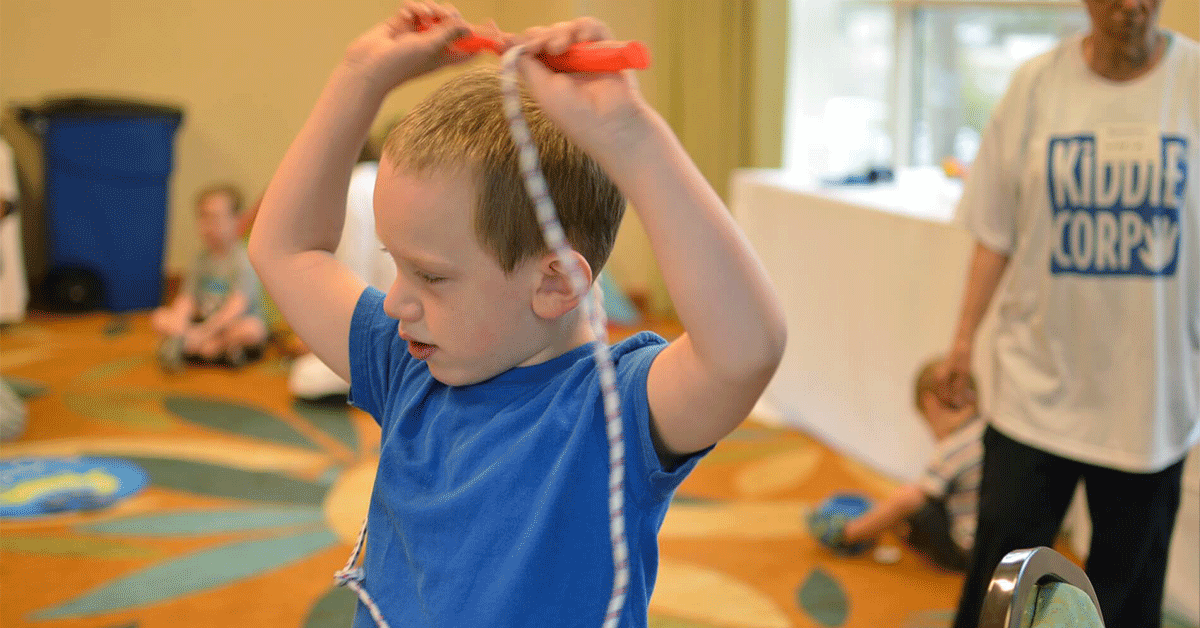When consulting with parents regarding behavior issues, the topic of time-out comes up during the majority of my conversations. Parents and professionals alike have used time-out as an effective tool for many years — even before it was called time-out. Research has supported its usefulness with typically developing children as well as those with delays such as ADHD.
Most parents whom I have consulted for say they have tried time-out at one time or another, and frequently state that it did not work for them. This was often puzzling to me, so in an attempt to find effective intervention strategies I probed into how the families were using time-out and where the problems were occurring.
I had them demonstrate their techniques for me. These conversations and observations revealed that it was not time-out itself that was ineffective, but its application to children with Fragile X syndrome. As I worked more extensively with these families, I found time-out could be an effective part of a comprehensive behavior plan, but only when I modified the process to fit the physical and developmental profile of the particular children. Clearly, adaptations were needed for this to be a useful tool for them. This accords with our knowledge that behavioral strategies designed and implemented with children who are typically developing frequently prove ineffective for those with special needs unless adaptations are employed to address their specific profiles.
In order to understand the adaptations, one must first understand the original construct.
Clinically, time-out is considered a punishment for inappropriate behavior. It is defined as time away from positive reinforcement. Many counselors, researchers, and therapists use variants of this theme to define the technique. This differs slightly from removal from a situation as a natural consequence. For instance, a child who spits their food during dinner loses the privilege of sitting with the family to eat. Or a child who acts out in circle time may be asked to leave the group. This is a natural consequence for that particular behavior, and can be used effectively in many situations. A notable exception would be if the original purpose of the behavior was to avoid the group activity.
Time-out is typically used for young children, but I have found it can be effective for children with Fragile X syndrome who range from preschoolers up through “tweens.” I hesitate to place a firm age limit on this technique, as children are so different and individual strengths and challenges must be considered.
I have found the following 10 time-out “rules” to be the keys to its success. These strategies are based on the fundamental principles of time-out, while incorporating adaptations that address the fact that children with Fragile X syndrome have language and attention difficulties that are best accommodated through additional considerations for repetition, consistency, and predictability.
1. Make time-out a process, not a place
If time-out is linked only to a specific place in the home or classroom, you are limited in both how and where you can use it. If you place your child on a kitchen chair or in his room as a consequence for hitting, what are you going to do if he hits in the grocery store?
My recommendation is to sit the child down right where the infraction takes place, or if they are already sitting, simply turn them around so that they are not facing you or the group. If you are in the grocery store, I recommend sitting the child down right where the infraction takes place. You can sit them down right in the aisle. Make sure that you position yourself so that they cannot leave or pull stuff down from the shelves. They are now in time-out. This differs from the information that is available in many parenting books and on the web. It is an important modification for children with Fragile X syndrome for many reasons, several of which will be addressed in the following recommendations.
The biggest and most common obstacle that parents have cited to me about using time-out is getting the child to the designated chair, corner, or step. This can be eliminated without rendering the process ineffective. It is a slight but crucial change in thinking: It’s not the location that matters — it’s the time away from your attention. The act of removing the child from your attention is, in the clinical sense, a punishment, and a deterrent for the behavior. Most children want attention.
Note: Although children with Fragile X syndrome may exhibit social anxiety, they are social beings. For children with autism, time-out presents an additional challenge, and it often is not effective for them. Consultation with a psychologist or behavioral interventionist is recommended.
It is important to note that although you can and should use time-out in a variety of places, you want to establish your processes at home and practice in a controlled setting before you take your show on the road. You would not initiate this process in a grocery store, but after you have used it successfully at home and then perhaps at Grandma’s house, you would be ready for public places.
2. Make sure time-out means time away from your attention
This is the most fundamental part of time-out, and one that appears to be the most difficult to implement. If you place children in time-out and talk to them about what they have done and why they are there, they are not in time-out; they are simply on the kitchen chair getting a lecture or engaging in an argument. Neither one of these strategies is effective in changing behavior.
Yes, you will need to communicate with your child in time-out, but in a very structured and routine way.
3. Decide on a simple and consistent phrase before you start
The use of a consistent phrase serves several purposes in the time-out process, and it should contain two basic components.
- The first part lets the child know what they did and that it is wrong.
- The second part lets the child know what is happening; it labels the process.
So for a child who hits, an appropriate phrase would be “No hitting, time-out.” This is very short for several reasons. Children with Fragile X syndrome typically have language delays, so more language will actually lead to less understanding. Most parents feel it is necessary to explain and rationalize the situation with their child. However, when you engage in discussion, you delay the time-out, which makes it more difficult for the child to link time-out with the undesirable behavior. By the time the child is actually in time-out, they may have forgotten what they did to get there.
Consistency of language also allows you to change location without disrupting the routine. You cannot take the kitchen chair with you to Grandma’s house, but you can take your time-out routine and your phrase.
It is important to choose the phrase that you want to use ahead of time so that you do not have to think about what you are going to say in the heat of the moment. In addition, everyone who is involved in changing the child’s behavior should use the same phrase. Consistency, consistency, consistency! Using a consistent phrase also keeps you from engaging in discussions and arguments. You have a set, minimalist response to any comment — “No hitting, time-out.” Changing behavior is tough, particularly when you are initiating something new. Using this same phrase can be calming for you. Ultimately, “No hitting, time-out” reminds both you and your child what they did and why they are in time-out.
4. Link time-out to a specific act or behavior
Time-out is not for generalized naughty behavior. We have all said “That’s it! You have been whining and grumpy all day. You can go to your room for time-out until you can come down and be nice,” or “You sit on this chair until you can calm down.” In order for the child to understand why they are in time-out, it must be clearly linked to a behavior. Behaviors are things like hitting, kicking, or biting.
Time-out should not be confused with a time to organize oneself. It is not the same as going to the quiet corner for children who have sensory integration issues. It is not part of a sensory diet; it is part of a behavior plan. Implementing time-out effectively can be challenging, and it should be reserved for major offenses.
5. Impose time-out immediately following the behavior
For time-out to be effective, you must establish a clear relationship between it and the undesirable act. This is particularly important for children with Fragile X syndrome, who have short attention spans and difficulties with sequencing and cause and effect. The shorter the time between the behavior and the time-out, the more easily the child is able to understand the relationship between the two — and the more effective time-out will be in decreasing the unwanted behavior.
6. Do not engage in dialogue
On the way to time-out, or during the time-out itself, many children will attempt to get your attention by arguing. They may deny their involvement (“I didn’t do it”), blame another child (“Liam hit me first”), or comment on their feelings about you or your parenting skills (“I hate you, bad mommy”). If you address any of these comments prior to or during time-out, the child has your attention, and they are not actually in time-out. It is very difficult not to comment on these statements, and that is why it is important to use the previously determined phrase “No hitting, time-out.” This is your mantra. It helps keep you from engaging with your child during the time-out process.
7. Do not address behaviors that occur along the way
As stated above, children will attempt to get your attention any way they can.
They will also attempt to delay time-out whenever possible. Hitting you, trying to bite you, and knocking down the planter next to the couch are all attempts to engage you and consequently delay or avoid time-out. If you address these behaviors, the child will learn quickly that kicking or spitting will work in delaying the punishment, and they will continue to use them.
By implementing time-out in the manner outlined in our first rule — make time-out a process, not a place — you decrease the likelihood of additional provocative behaviors. You are not dragging the child to their room or lifting them onto the second step, so they have less of an opportunity to employ negative behaviors. The focus thus remains on the original behavior — hitting. It is important to note here that all children at some time or other will attempt to use these strategies. Nobody wants time-out, it is not fun. That is what makes it an effective tool.
“Nobody wants time-out, it is not fun. That is what makes it an effective tool.”
It is also important to note that children are not “bad” just because you’re having to employ time-out. It doesn’t mean your children are unusually manipulative or strategic. Our brains are simply designed to work this way. We all avoid things that we do not like or are unpleasant, and we repeat things that work for us.
8. Adjust the duration of time-out to the child
Two commonly asked questions are:
- How long should the child stay in time-out?
- How many times should I put them back?
These questions are related, since keeping a child in time-out beyond their ability to handle it often leads to them getting up repeatedly.
Again, we need to think about how the brain works, and more specifically, how a brain with Fragile X syndrome works. The rule of thumb for time spent in time-out is one minute for every year, so a three-year-old child would spend three minutes in time-out. This works fine for typically developing children, but for children with Fragile X syndrome, I recommend cutting the time in half. Such children typically have attention issues that need to be considered. It would be unreasonable for them to be able to stay in one place for as long as a child their age without Fragile X syndrome.
“The rule of thumb for time spent in time-out is one minute for every year, so a three-year-old child would spend three minutes in time-out. … but for children with Fragile X syndrome, I recommend cutting the time in half.”
We also want the time-out process to be successful for all involved. Keeping children in time-out for too long will result in frustration for parents, teachers, and children.
The second question is answered quite easily but again can be quite difficult to put into practice. If the child leaves time-out, you need to put them back as many times as it takes until they stay for the predetermined amount of time. Remember, this is a punishment for specific behavior. You put them in time-out and you need to tell them when it has ended. When the child attempts to leave the situation, remember to use your phrase rather than commenting on their leaving.
If they get up or attempt to leave and you say, “Now Justin, you need to get back in time-out,” or “I told you that you have two more minutes,” the child has your attention and is no longer “in” time-out. If the child attempts to get up or to leave, sit them back down and say, again, “No hitting, time-out.” You have thus kept engagement with them at an absolute minimum, and the focus is redirected back to the original offense.
9. Make time-out one component of a comprehensive behavior plan
Time-out is not a comprehensive behavior plan in and of itself. It is an effective consequence for many behaviors, but to change behavior, one must institute a complete plan that addresses all the factors that may be influencing it, including medications the child may be taking, therapeutic and remedial interventions such as speech and occupational therapy, and environmental factors. Comprehensive plans, by definition, require the coordination and collaboration of parents and professionals.
10. Use time-out in a consistent manner
Consistency is the key to success in any behavior plan — and the most difficult to employ. If you decide that a child should go to time-out every time they hit, then you need to follow through, even when you are out in public or even when the child is tired. If you start making exceptions, what you have actually taught the child is that sometimes you can hit and sometimes you cannot. This has the effect of strengthening the behavior. Still, consistency is difficult to maintain, so do not be too hard on yourself.
As I have advised many parents, do not try to implement any behavior plan when you are tired or on a trip. Set aside a weekend when this is your priority. I know in our busy schedules this is easier said than done. But if you need to address a behavior effectively, a comprehensive plan requires an initial time investment. It will pay off in the end. It is also important to note that time-out expectations for a typically developing child may look very different than those for a child with Fragile X syndrome.
Remember the ultimate goal for the procedure. In other words, do not get hung up on whether or not the child is sitting or lying down. That is not the behavior you are trying to change; you are trying to decrease hitting.
I have found the modifications and guidelines discussed above to be very effective for children with Fragile X syndrome. I have successfully guided parents and other caregivers through this process and have implemented it during home consultations. However, as is the case with any comprehensive behavior plan, it is always important to consult with a professional for support and guidance in dealing with difficult and challenging behaviors.






